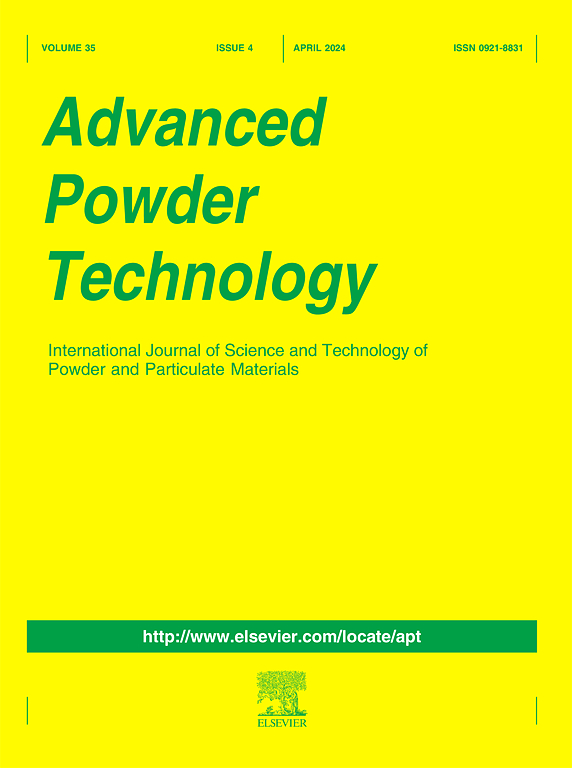Spectroscopic characteristics and characterizations of CaAl12O19-based phosphors for anti-counterfeiting applications and performance predictions
IF 4.2
2区 工程技术
Q2 ENGINEERING, CHEMICAL
引用次数: 0
Abstract
The CaAl12O19/ZnO (CAO/ZO), CaAl12O19/MoS2 (CAO/MS), and CaAl12O19/LiPF6 (CAO/LPF) phosphors with different mass percentages were synthesized. The CAO/ZO and CAO/MS phosphors contained no other impurities except the target products, but CAO/LPF phosphor also contained LiF and LixPOyFz impurities due to the high temperature thermal decomposition of LPF. The fine particles of ZO, MS or LPF were uniformly attached to the surface of CAO, forming a special interface contact. The coupling CAO with ZO and MS significantly reduces the optical band gap (Eg) value of CAO, while LPF coupling CAO does not affect the Eg value of host lattice. The CAO/ZO, CAO/MS, and CAO/LPF phosphors were shown to be sky blue, blue, and dark blue, respectively, during the photoluminescence characterization, which resulted in the emission peaks that were predominantly concentrated at 487, 467, and 459 nm, respectively. An intelligent algorithm model was used to predict the photoluminescence properties of CAO-based phosphors, and it demonstrated exceptional predictive ability. The CAO/ZO, CAO/MS and CAO/LPF phosphors exhibit different photoluminescence properties due to the radiative recombination of localized excitons, type I band arrangement and impurity promoting electron and hole recombination, respectively. Photoluminescence applications show that the CAO-based phosphors demonstrate multimodal fluorescence anti-counterfeiting under different excitation wavelengths.

用于防伪应用和性能预测的基于caal12o19的荧光粉的光谱特性和表征
合成了不同质量百分比的CaAl12O19/ZnO (CAO/ZO)、CaAl12O19/MoS2 (CAO/MS)和CaAl12O19/LiPF6 (CAO/LPF)荧光粉。CAO/ZO和CAO/MS荧光体除目标产物外不含其他杂质,但由于LPF的高温热分解,CAO/LPF荧光体中还含有LiF和LixPOyFz杂质。ZO、MS或LPF的细颗粒均匀附着在CAO表面,形成特殊的界面接触。CAO与ZO和MS的耦合显著降低了CAO的光学带隙(Eg)值,而LPF耦合CAO对主晶格的Eg值没有影响。在光致发光表征中,CAO/ZO、CAO/MS和CAO/LPF荧光粉分别表现为天蓝色、蓝色和深蓝色,发射峰分别主要集中在487、467和459 nm处。采用智能算法模型对氧化钙基荧光粉的光致发光性能进行预测,结果表明该模型具有较好的预测能力。CAO/ZO、CAO/MS和CAO/LPF荧光粉分别由于局域激子的辐射重组、I型能带排列和杂质促进电子和空穴重组而表现出不同的光致发光特性。光致发光应用表明,在不同激发波长下,氧化钙基荧光粉具有多模态荧光防伪性能。
本文章由计算机程序翻译,如有差异,请以英文原文为准。
求助全文
约1分钟内获得全文
求助全文
来源期刊

Advanced Powder Technology
工程技术-工程:化工
CiteScore
9.50
自引率
7.70%
发文量
424
审稿时长
55 days
期刊介绍:
The aim of Advanced Powder Technology is to meet the demand for an international journal that integrates all aspects of science and technology research on powder and particulate materials. The journal fulfills this purpose by publishing original research papers, rapid communications, reviews, and translated articles by prominent researchers worldwide.
The editorial work of Advanced Powder Technology, which was founded as the International Journal of the Society of Powder Technology, Japan, is now shared by distinguished board members, who operate in a unique framework designed to respond to the increasing global demand for articles on not only powder and particles, but also on various materials produced from them.
Advanced Powder Technology covers various areas, but a discussion of powder and particles is required in articles. Topics include: Production of powder and particulate materials in gases and liquids(nanoparticles, fine ceramics, pharmaceuticals, novel functional materials, etc.); Aerosol and colloidal processing; Powder and particle characterization; Dynamics and phenomena; Calculation and simulation (CFD, DEM, Monte Carlo method, population balance, etc.); Measurement and control of powder processes; Particle modification; Comminution; Powder handling and operations (storage, transport, granulation, separation, fluidization, etc.)
 求助内容:
求助内容: 应助结果提醒方式:
应助结果提醒方式:


